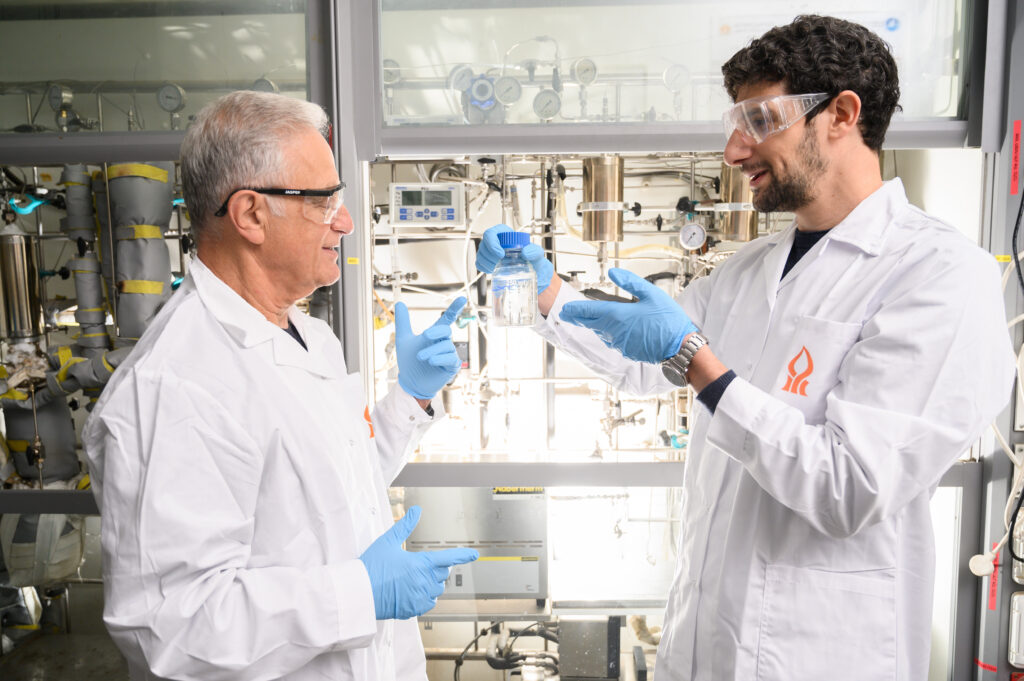
A New Road to Energy Efficiency
June 24, 2014
IMPACT Spring 2014 –“Imagine lighting a candle and using its heat to operate an electrical device, without plugging it into the wall,” Dr. Yaniv Gelbstein says, explaining the aspirations of his research field: thermoelectrics.
This relatively young discipline focuses on the interaction of heat and energy. While the work starts on the basic science level, major applications beckon.
Converting wasted heat into electric energy that will power engines more efficiently, for example, is high on the global agenda. This approach to conserving energy could dramatically reduce the need for fossil fuel with all the attendant benefits.
Dr. Gelbstein heads the Laboratory of Thermoelectrics and the division of electronic materials at BGU’s Department of Materials Engineering. The lab has earned a reputation as one of the most important national centers of materials education and research in Israel. It collaborates with major players in the auto industry, including Rolls-Royce and Jaguar, as well as the Israeli military.
All eagerly await energy technologies for vehicles that are already partially on the drawing board.
IT STARTED WITH SPACESHIPS
The thermoelectrics field launched in the 1960s, Gelbstein says, when both the United States and the then-Soviet Union created new systems to power spacecraft. They developed semiconductors constructed of totally different materials that produced large amounts of electricity from the heat generated by the decay of radioactive materials.
The systems were efficient and reliable, but plutonium is not well suited to everyday uses on earth. Researchers now work to develop novel materials to bring the benefits of thermoelectrics to practical devices.
In addition to drawing on chemistry, physics and multiple engineering disciplines, Gelbstein, a member of BGU’s Ilse Katz Institute for Nanoscale Science and Technology, works on the nanoscale level to create new materials with properties he chooses.
While scientists in many areas of energy research are exploring nanostructuring, Gelbstein’s lab confronts a special issue. “When devices with nano-materials are subjected to very high temperatures—as in a car engine —the material’s nano-features tend to coarsen. So you may start with materials made of very small features, but with heat they become bigger and you lose the properties you want. We look for thermodynamic reactions that stay stable at high temperatures.”
Recently, Gelbstein—whose labs are fueled by 20 enthusiastic Ph.D. and master’s students—found one such reaction. “It can give us fine patterns and high efficiencies, and stabilizes the nano-features at high temperatures,” he says.
Progress in energy research is measured by an engineering term called “Figure of Merit,” which indicates a system’s relative efficiency.
“This value for materials commonly being used in practical applications, like car engines, exhibit thermoelectric properties with a value of one. Our novel approaches can give us a value of two, so our materials are twice as efficient. They’re the best thermoelectric materials in the world. Now we want to take these materials into practical devices, like cars.”
ACHIEVING ENERGY EFFICIENCY
How much more efficient auto engines can become varies on the specific engine and use.
Gelbstein notes that car engines waste 70 percent of incoming energy as heat, mostly expelled by their exhaust systems. So the potential is huge for minimizing energy loss through channeling heat into electricity to help run the car. Auto companies are already devoting research and development efforts into operating more car functions electrically.
“They believe in this technology,” Gelbstein says. “You don’t have to convince them—they analyzed this option as viable, so they’re waiting for the technology.”
He estimates that given current findings and budgets, applications in practical devices are possible in as little as three years.
Another measurement scale to track progress is technological readiness level (TRL). The minimal level is one, while the highest figure, nine, represents a final product in use. Thermoelectric projects around the world—including BGU’s—are between the third and fifth stage, and bridging the gap will take a lot of work, Gelbstein notes.
He runs one lab devoted to synthesizing new materials and a second whose job is to characterize their mechanical, physical and electrical properties. A lot of trial and error is involved, he affirms. “Every day we have new questions about things we didn’t expect. After the material is characterized, it loops back for the experimental lab to improve or synthesize it again.”
In addition to the auto industry, interest in thermoelectric applications is strong from producers of marine vessels, locomotives, tanks, and satellites. The BGU group has academic partners in the European Union and the U.S., including Northwestern University and the University of Michigan.
Gelbstein considers himself fortunate to have established his expertise early, when thermoelectric specialists formed a small community in the world. He spent 15 years in the industry as a leading researcher in materials science before undertaking his Ph.D. at BGU, where he also obtained his B.Sc. and Msc. He stayed on to lecture and lead the thermoelectric group.
“I understood for years that there was something unique about the field, but couldn’t predict that countries would be so motivated to reduce dependence on fossil fuels. I was in the right place at the right time.”
BGU is similarly well positioned, he believes. “Israel is a small country and compared to the biggest universities, BGU is a small one, but it is well equipped and benefits from a special drive,” Gelbstein says.
“We work hard for results. We design and build methodologies by ourselves. Then our work is appreciated…and we get the funds to move ahead.”
Read more about green energy research in a special feature in the next issue of Impact. To learn more about BGU’s Energy Initiative now, visit www.bgu.ac.il/energy.




